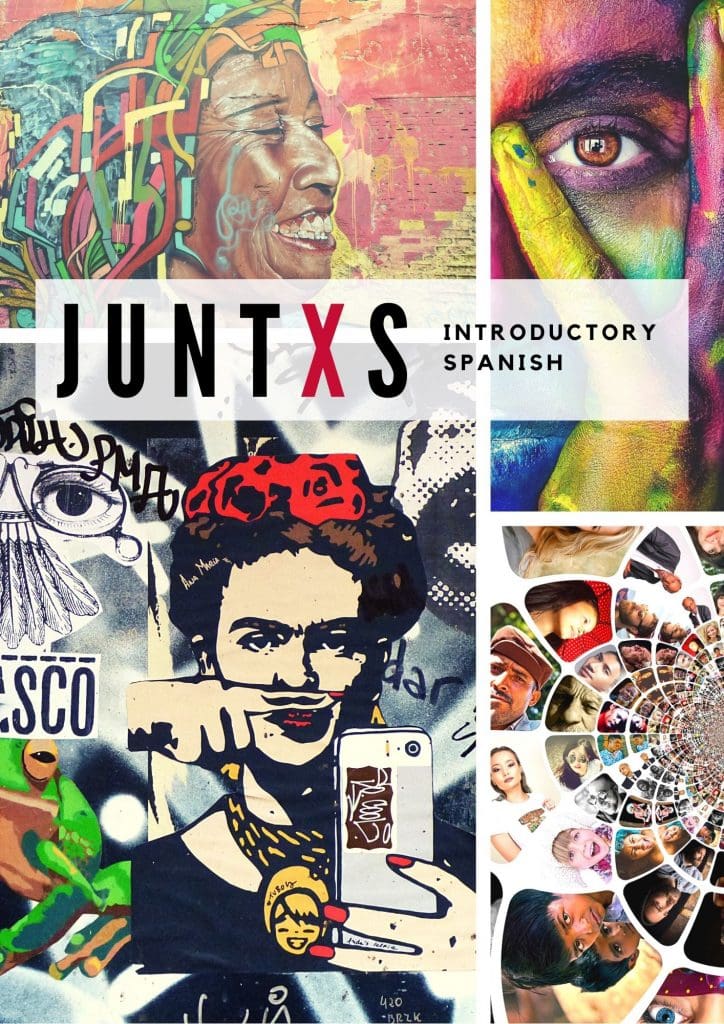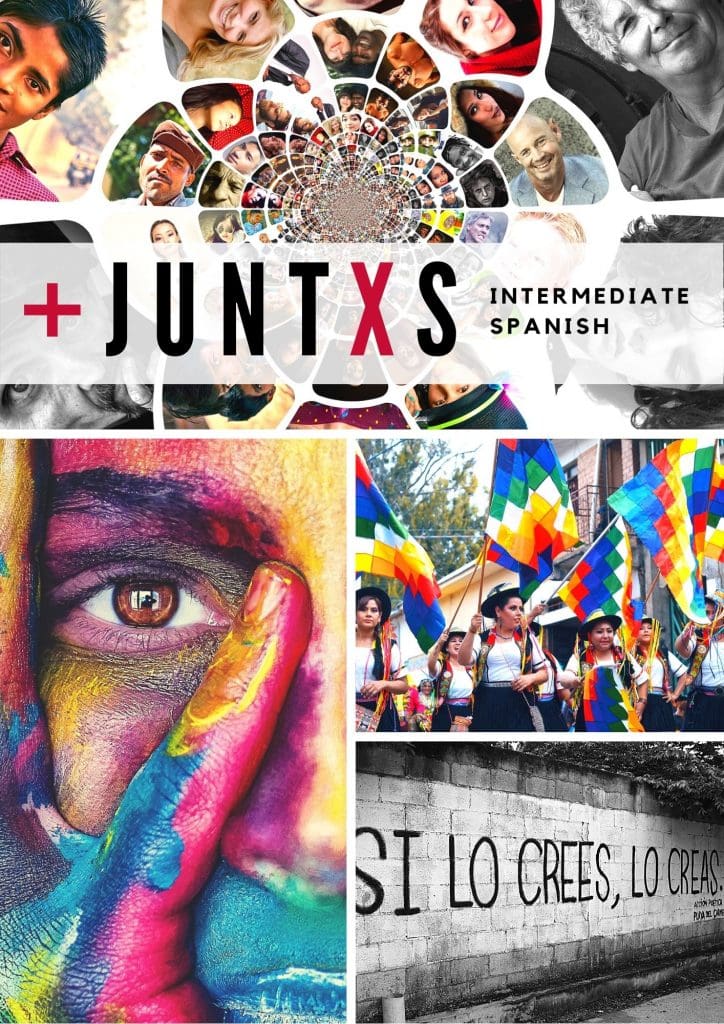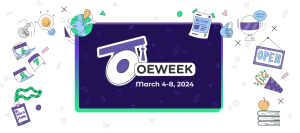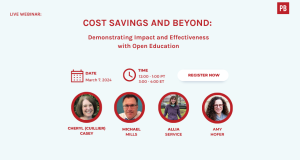When offering examples of creatively designed open educational resources (OER), JUNTXS and its sequel + JUNTXS are usually near the top of the list. These are interactive textbooks for students of Spanish, complete with a wide range of embedded content to help immerse the reader, such as interactive videos, social media, dialogue cards with audio, matching and multiple-choice questions, and more. Each module ends with a Spotify playlist of Spanish-language songs related to the content that was just covered. The books acknowledge the diverse intersectionality within the Spanish-speaking world and consider the legacy of colonialism as well as the typically underrepresented groups that may not often be considered in language textbooks. JUNTXS’ (the title is a modified version of “juntos/as” and translates as “together”) stated aim is to “fuel our curiosity, encourage active reflection on our own and others’ ideas and perspectives, and to stretch our social, political and ecological imagination in general, as well as in relation to the study of the languages and cultures of the Spanish-speaking world.”
I spoke with the author, Dr. Adriana Díaz of The University of Queensland, about why she chose to create these OER and her process along the way.
Find JUNTXS and + JUNTXS along with thousands of other OER in Pressbooks Directory.

Could you tell me a bit about your background and how you got started with Open Educational Resources? What made you decide to write this book, in particular?
I was born in Buenos Aires, Argentina but have now lived over half my life in Brisbane, on the unceded lands of the Turrbal and Jagera Peoples. For nearly two decades, I have been involved in teaching across Applied Linguistics, English, Italian, and Spanish language programs in the Australian university context. I am currently Program Convenor and Senior Lecturer in the Spanish and Latin American Studies Program at the School of Languages and Cultures, at The University of Queensland.
Over the past few years, I have been actively developing a pedagogical vision that is constructively and creatively aligned with my praxis, particularly in the teaching of ab initio and intermediate-level Spanish language courses. In 2020, I made the decision to forgo commercially available textbooks, which had long been used as de facto curricula in the courses I coordinate, a common practice in the field of languages education.
This decision was primarily guided by a desire to ensure equitable and sustainable access to our learning resources and increase the level of representation in the curation of themes, images, authentic audio, and video material as well as citation practices.
Was there a gap in the subject matter? Did you feel that existing language resources were incomplete?
YES. While there are many excellent commercially available textbooks and many emerging OERs targeting (Spanish) language learners, my feeling was that none of them focused on disrupting histories of intersectional exclusion and social injustice in the (Spanish-speaking) world, at least from the beginner, novice language learner level. I was looking for resources that centred marginalised communities, and that also provided wider representations of authentic voices on topics that were relevant to our learners and teaching context. Finally, most mainstream language learning/teaching resources available neglect to engage explicitly with pervasive language ideologies and (long-standing) translanguaging/translingual practices.
My positionality as a racialized migrant and my grappling with feelings of uprooted existence and an embodied lineage of colonial history in my life and my work as a Spanish and Latin American Studies scholar were all entangled in this vision. Australia finds itself still coming to grips with the legacy of settler-colonialism, not as a past, historical event, but as an everyday, painfully lived experience for many. I felt that in our courses we could draw on these connections to address intersectional inequalities (facing questions around language, gender, sexuality, race, social class, religion, etc.).
When beginning JUNTXS, what made you choose OER versus another method of book publishing? Was it the ability to adapt to a cultural context? Was it the technical aspect, like the ability to embed media?
At the end of 2020, my university acquired access to the Pressbooks platform and began developing a university-wide OER publication strategy. I was then contacted by our Faculty Librarian as she was aware that I had been trying to find an alternative to commercially available Spanish language learning textbooks. I was immediately attracted by the affordances of the Pressbooks platform and the support that the UQ library was able to provide.
Throughout 2020, I had already been working on the creation of interactive learning content through H5P and other available online tools such as Padlet and Genially. As such, the publication of an institutionally supported OER offered me the possibility of threading all this content together and explicitly outlining their overarching rationale.
Most importantly, the OER publication method responded to a key imperative: the desire to challenge the notion of knowledge as static and hierarchical and of “traditional textbooks” as monolithic, de-contextualised and pre-packaged, to move toward the sustainable (co)designing of “living”, ever-evolving learning resources, which centre marginalised (learner) voices and their contribution through iterative, and recursive open dialogue.

I’ve seen JUNTXS get recommended by others in the OER community, and I’ve included it in different OER collections as a great example of creative interactive content, immersive learning, and cultural awareness. Different people have different learning styles, but JUNTXS is so varied in its content that I think it would work well for most students. Could you tell me about your process for creating this book? Did something inspire the creative decisions, such as the “banda sonora” music playlists?
Yes, I envisaged these resources as including media-rich, visually arresting, multimodal content that reflected authentic voices and lived experiences. I also wanted to ensure that content included the full spectrum of social media network platforms, such as Instagram, Twitter, Spotify, Facebook, LinkedIn, blogs, and so on—channels that learners would access “beyond the classroom walls” and that draw on their existing levels of multimedia multiliteracy.
The concept of the “banda sonora” emerged from the idea that each module could incorporate a collectively created soundtrack of artists and songs from around the Spanish-speaking world, thus enabling exposure to their wide-ranging accents, rhythms, and histories. Spotify offers the possibility of creating such collaborative playlists, which allow learners (past, present, and future) to add artists and songs that reflect their preferences and experiences, and, in so doing, open small windows into their own engagement with the topics covered in each module.
JUNTXS is a work in progress, but it’s getting attention both as an educational resource and as an example for other OER creators to follow. Some authors prefer to unveil a finished work at the very end, while others continually update their work to keep it relevant. Was it important for you to share JUNTXS as a work in progress?
This is such an interesting question! I think this idea responds to the vision of these OERs as “living,” forever unfinished, work in progress resources that can evolve and remain relevant through the input of the (language learning and scholarly) community. As such, sharing JUNTXS as a work in progress aims to foreground the organic, iterative, non-linear, often unpredictable, cumulative nature of knowledge creation.
When I read your description of the learning modules, you say they are “designed to fuel our curiosity, encourage active reflection on our own and others’ ideas and perspectives, and to stretch our social, political and ecological imagination in general, as well as in relation to the study of the languages and cultures of the Spanish-speaking world.” The book is presented as a resource for language learning, but it really seems like more than that: It’s also about broadening our horizons to better understand the cultural and historical issues at play, and to think critically about our place in the world. Is that a fair assessment? How did you come to such a holistic style of teaching?
YES, thank you so much for your words! I have long felt that the language learning and teaching endeavour entails a deeply transformative (and often uncomfortable) process. Yet, the overreliance on readily available teaching materials significantly hinders this process as these materials tend to overlook (and/or completely erase) histories of oppression, intersectional inequalities, and injustices as well as the disturbing impact of the unfolding climate crisis on our very existence in the world. As such, I see engagement with language learning as an opportunity to interrogate and deconstruct these realities to (un/re)learn about the pluriverse of possible ways of thinking, being, and doing that surround us all.
The title JUNTXS means “together,” and you say your aim is to “learn together, from and with” your students. Does this describe your general approach to pedagogy? How does that translate to a classroom setting?
Yes, learning together, from, and with each other is a key component of the pedagogical stance in our courses. In the classroom setting, this stance is reflected in the incorporation of activities that centre around open questions aimed at denaturalising shared, collective imaginaries and generating critical (self-)reflection on any given topic. These questions often shine the spotlight on the self and the local context (be it Australia or other places from where our students are engaging with us) and require our opening up to sharing personal anecdotes and experiences. Creating a sense of (learning) community is thus key for this sense of reciprocity, togetherness, and belongingness to emerge and to facilitate, in turn, transformative learning experiences for both students and teachers alike.
What can people expect from JUNTXS in the future?
The next step in realising this vision for JUNTXS is through a “students as partners” project, which we will be implementing next year. Through this project, we will recruit past students to engage with peers to further understand students’ motivations and challenges in the process of learning Spanish as a second language in the Australian context. In so doing, student-partners will also help co-evaluate existing modules and complete the design of learning modules already underway. Student partnerships will allow us to incorporate student voices through student-centred content, generated and developed by and for fellow students.
In future iterations of these partnership projects, we will also aim to consider issues of accessibility, for instance, ensuring that all our images include Alt text, and providing alternative options such as captions/subtitles or descriptions for videos, audio for texts, and transcripts for audio.
We also hope to attract contributors from around the world, willing to add their voices to the creation of content so that JUNTXS can truly reflect a pluriverse of perspectives.
Dr. Díaz’s acknowledgments: I would like to acknowledge the support of the School of Languages and Cultures at UQ as well as the Spanish and Latin American Studies Program in the early conceptualisation process of these resources, in particular, Ms Ruth-Sara Sánchez Asún and Ms Jessica Cockerill. I would also like to express my most heartfelt gratitude to Ms Felicity Berends and Ms Justine Cawley from The University of Queensland Library for believing in me and helping me make these resources a reality.




